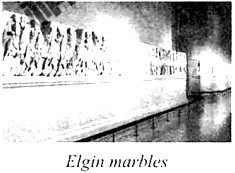Antiquities are ancient objects and artworks. Museums acquire works to display from many different sources. Sometimes they purchase them. Other times they receive donations. Today there are strict rules forbidding art that has been stolen from other countries. However, antiquities that have been at museums for decades or even centuries may have arrived there by questionable means. Now, some countries claim that museums have a responsibility to return these antiquities to their original locations.
There are many examples of this debate. Perhaps the most famous is the argument between Greece and the UK over the Elgin marbles. In the early 19th century, the Earl (伯爵) of Elgin had numerous sculptures taken from Greece to the UK. When Elgin did this, Greece was still a part of the Ottoman Empire. He claimed that he had received a permit to export the sculptures. Today the marbles are on display in the British Museum^ However, Greece wants them to be returned to their original location.

Should museums return these antiquities? Experts disagree. Malcolm Bell III says yes. Bell is a retired professor of art at the University of Virginia. He says, “Many antiquities and artworks have special cultural value for a particular community or nation. When these works are removed from their original cultural setting they lose their context and the culture loses a part of its history.”
According to Bell, a country's request for the return of an antiquity “usually has a strong legal basis.” It “was exported illegally, and is now stolen property.” He called the return of antiquities “an expression of justice.”
James Cuno says not always. Cuno is president of an art museum in Los Angeles. He is also the author of the book Who Owns Antiquity?. Cuno agrees that museums have “a social and legal responsibility” to return illegally exported antiquities. However, he doesn't support the return of legally acquired works.
“An area of land held today by a given nation-state in the past likely belonged to a different political entity (实体). Even if one wanted to reunite scattered works of art, where would one do so? Which among the many countries, cities, and museums in possession of parts of a work of art should be the chosen 'home' of the reunited work?” Cuno believes that museums should collect art from the world's diverse cultures. This should be done “through purchase or long-term loan and working in cooperation with museums and nations around the world.”
This debate is far from over. As a complex question with no easy answer, the issue requires more study.